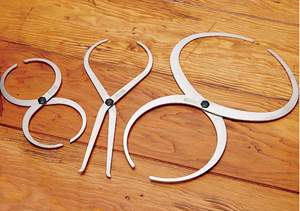
How do you determine the thickness of the sides of a bowl when you are turning the inside? Cutting through the sides of the bowl is not fun! – Jim Winslow
Tim Inman: You need a special set of calipers. Sometimes simply called “double-ended” calipers, each of two legs is shaped in a sine curve, and the pair together form a “figure of eight,” hinged in the middle. With these, when the set of points on one end touch each surface of your bowl, the thickness is displayed by the gap on the other end. There are other caliper configurations available, too. The others offer more precision measuring, but I like the plain old double-ended ones for turning, as with them I can quickly see the wall thickness all along the bowl as I slide the calipers along — and I’m really not needing to know how many thousands thick my bowl is. I just want to keep my project from becoming one shorter bowl and one matching loose wooden ring.
Chris Marshall: I use the same double-ended calipers as Tim, and they work great. But I use my fingers just about as much to verify that wall thickness is consistent and, for lack of a better term, “right” for the piece I’m turning. By that, I mean the walls are appropriate by my estimation for the size of the bowl. A small bowl with chunky-thick walls looks like I stopped before removing enough wood, and a large bowl with paper-thin walls looks like it won’t hold up its own weight, much less a bunch of apples. Wall thickness is both an aesthetic and practical issue for me.





